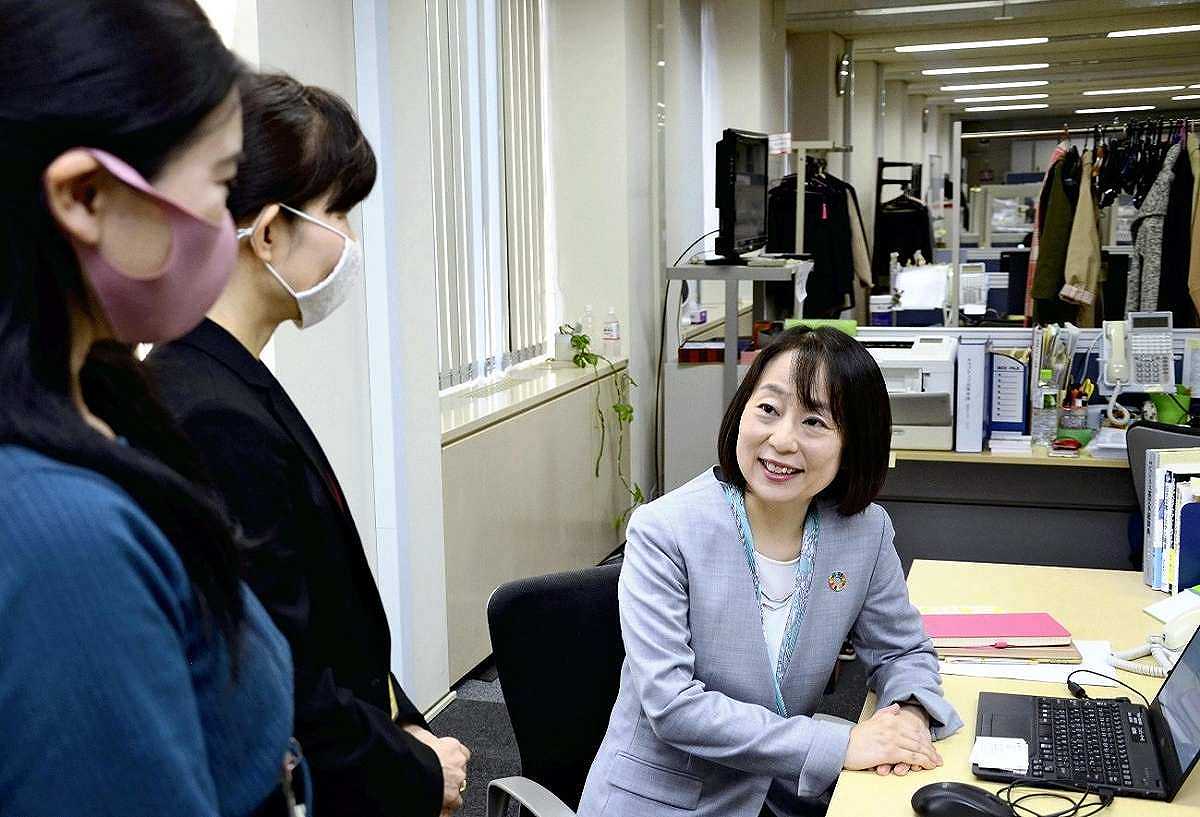
Emiko Maki, an executive officer at Sompo Japan Insurance Inc., right, speaks with colleagues in Shinjuku Ward, Tokyo, on Nov. 10.
13:25 JST, December 8, 2020
Despite a government-set target aiming to boost the proportion of women on company boards, the gender gap remains wide 4-1/2 years after the implementation of a law promoting women’s advancement.
According to a Yomiuri Shimbun survey conducted on 111 major companies nationwide in October, the percentage of female board members averaged 7.7% as of April 2020.
This figure is short of the goal to increase the percentage of women on boards at listed companies to 10%, which the government set in 2016 when the Law on the Promotion of Female Participation and Career Advancement in the Workplace was implemented.
It is believed that having more women on boards increases the growth potential of firms. Companies are required to be more proactive such as by changing the mindset of top executives.
70% of firms failing
The percentage of female board members has increased from an average of 4.9% in April 2016, when the law went into effect — 73% of the firms surveyed reported rises as of April this year.
However, at about 70% of the companies, less than 10% of board members are women, and 10 have no female executives at all.
The government’s goal for the advancement of women in the ranks of management is still only midway to being achieved.
Companies should promote women to their boards as it is expected to increase the firms’ growth.
“The inclusion of women in decision-making gives rise to different perspectives, which leads to a change in thinking and management innovation,” said Yukako Uchinaga, board chair of Japan Women’s Innovative Network (J-Win), a nonprofit organization that supports the promotion of women’s advancement in companies.
“[The participation of] women in management is the first step toward incorporating diversity into the management team,” she said.
There are also advantages in terms of financing. Amid growing interest in investments that include environmental, social and governance considerations — popularly known as ESG or socially responsible investing — efforts to promote women’s advancement have also become an indicator of a company’s growth potential.
30% Club
According to a survey conducted by the Gender Equality Bureau Cabinet Office, when asked what institutional investors require of companies in relation to the disclosure of information on women’s advancement, nearly 49% of them answered “the ratio of female directors.” This answer received the highest rate of response.
To help in deciding on investments, a new type of index on gender diversity has appeared. The Government Pension Investment Fund has adopted the MSCI Japan Empowering Women Index (WIN), which calculates gender-diversity scores based on various information disclosed under the law.
Economic circles are also expanding their efforts to raise the number of female executives.
The Japan Business Federation (Keidanren) has set a goal of increasing the percentage of female board members, including corporate officers, to 30% or more by 2030, according to a new growth strategy released in November.
The 30% Club Japan — launched in 2019 with corporate managers as members — is also working on increasing the percentage of female board members to 30%. The organization, which follows in the footsteps of Britain’s 30% Club, focuses on the training of female board candidates.
Several women on boards are being asked to play a pioneering role.
Emiko Maki, an executive officer at Sompo Japan Insurance Inc., is responsible for training a diverse workforce. “I want to use my experience as a woman to help realize a company where diverse personnel can thrive,” she said.
Akiko Kagawa, president of Hakata Daimaru department store, said: “Female executives are receiving a lot of attention from outside of companies. A company where women are comfortable working is also comfortable for men.”
Candidate training an issue
Balancing work and family, however, was a major barrier for Maki in being selected as a board member. Maki, who gave birth to her first son in 2000, recalls that she was only able to devote herself to her work with the support of her parents who lived nearby.
“The way of working that assumes long hours is a major factor in why women who are raising children are losing opportunities for promotion,” she said.
Little progress in the task of training female candidates for executive roles is another problem that was mentioned.
According to the Yomiuri Shimbun survey, the rate of women in management positions, which makes them candidates for board members, was 9.9% on average.
One firm that had a lower percentage of women on their board compared to 2016 said that there were not enough female candidates.
J-Win’s Uchinaga pointed out the need to change the mindset of men in order to solve the problem. “It’s difficult for women to get into a male-dominated management team. In order to break down the barriers, it is important for top management to come up with a management strategy to promote women’s advancement,” she said.
Moving away from ‘Showa model’
In 2003, the Japanese government set a goal of increasing the percentage of women in leadership positions in all fields to about 30% by 2020. The goal was based on what is happening overseas, among other circumstances. But the government’s target did not draw much attention until 2012, when the second Cabinet of Prime Minister Shinzo Abe was inaugurated.
The Abe administration made women’s advancement a pillar of its growth strategy. In 2013, the Cabinet requested that business circles include at least one woman on the board of all listed companies. The Law on the Promotion of Female Participation and Career Advancement in the Workplace, which encourages companies to promote women to higher positions, came into effect in 2016.
Outside of the economic sphere, the Law on Promotion of Gender Equality in the Political Field came into force in 2018 as part of efforts to increase the number of female legislators.
But the percentage of women in the House of Representatives was 9.9% as of Jan. 1, 2020, showing that the move to promote women has been slow in both the economic and political fields.
In other countries, women’s advancement has progressed at a faster pace due mainly to the introduction of quota systems that stipulate in law the percentage of female board members.
Norway has set the required percentage of female executives at 40% or more, and other countries such as Iceland, the Netherlands and Spain have also put laws into force to increase the percentage of female executives.
The quota system is also expanding in the political arena, with 60 countries adopting candidate quotas, and 26 countries adopting seat quotas, according to the Cabinet Office.
The World Economic Forum, a private Swiss research organization, releases the Global Gender Gap Report annually, ranking 153 countries on their progress toward gender parity on 14 items in four areas: politics, economics, education and health.
Japan came in at a record low of 121st in the gender equality ranking released in December 2019. Low female participation in politics in the roles of Cabinet ministers and Diet members, as well as a low percentage of women in managerial positions in the economic sector were major factors.
“The promotion of women’s advancement in Japan has been limited to asking for cooperation from political parties and companies. [The government] has not taken effective measures,” said Takashi Kashima, a long-time member of the Council for Gender Equality of the Cabinet Office, and an adviser to the Japan Association for the Advancement of Working Women.
“Japan has not been able to break away from the ‘Showa model,’ which relies on women for household chores and childcare, as there is still widespread belief in society in the division of gender roles. The question is whether we can create a new ‘Reiwa model’ in the future,” he said.
"Politics" POPULAR ARTICLE
-

Japan to Support Central Asian Logistics Route That Bypasses Russia, Plan to Be Part of Upcoming Summit in Tokyo
-

Japan to Tighten Screening of Foreigners’ Residential Status by Providing Information of Nonpayment of Taxes
-

Chinese, Russian Bombers Flew Unusual Path by Heading Toward Tokyo; Move Likely Meant to Intimidate Japan
-

Japan Plans National Database to Track Foreign Ownership of Real Estate, Land as It Weighs New Rules
-

Up to 199,000 Deaths Estimated From Mega-Tsunami; Most Recent Occurrence Took Place in 17th Century
JN ACCESS RANKING
-

Tokyo Economic Security Forum to Hold Inaugural Meeting Amid Tense Global Environment
-

Keidanren Chairman Yoshinobu Tsutsui Visits Kashiwazaki-Kariwa Nuclear Power Plant; Inspects New Emergency Safety System
-

Imports of Rare Earths from China Facing Delays, May Be Caused by Deterioration of Japan-China Relations
-

University of Tokyo Professor Discusses Japanese Economic Security in Interview Ahead of Forum
-

Japan Pulls out of Vietnam Nuclear Project, Complicating Hanoi’s Power Plans



-250x167.jpg)






















